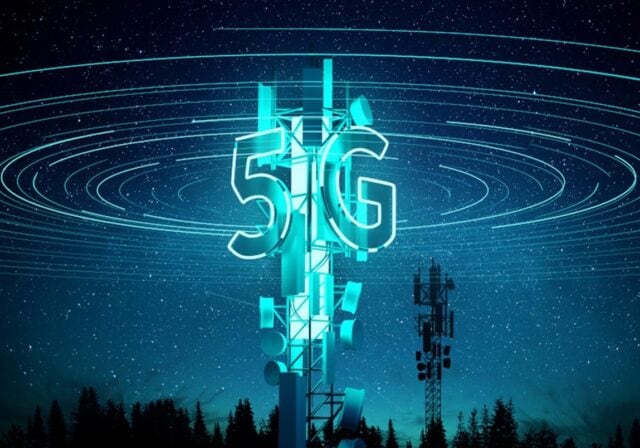Unlike its predecessors, this next-gen wireless network technology is the key to future innovations. Not only will 5G transform how you stay connected at home and on-the-go, but it will also revolutionize things like healthcare, transportation, education, and beyond! Throughout this article, we’ll explore what 5G is, 5 key advantages of 5G technology, and 4 5G use cases in business, government & education.
What is 5G and how does it work?
5G is the “fifth generation” of wireless technology, succeeding 4G. The “G” refers to the generation, and each new generation has brought faster connections and new capabilities. 3G first brought internet to mobile phones at basic speeds, enabling limited browsing with slow download speeds, while 4G allowed for new advances in wireless connectivity, including streaming, the adoption of video on social networking platforms, and even ridesharing apps, to name a few.
Through low-, mid-, and high-band frequencies, 5G technology unlocks instant, high-quality content downloads, video streaming, connectivity for multiple devices, and more. The super-fast speeds provided by 5G mean that data transfers can now happen at a rate that was impossible to imagine - even just a few years ago. 5G isn't just about faster downloads - it's the backbone for a future where everything is connected, instant, and intelligent.
What are the benefits of 5g?
5G offers several key benefits, including unprecedented speeds, reduced latency, increased bandwidth, reliable connectivity with network slicing, and enhanced connectivity with mmWave technology. Let’s dive into the specifics of each advantage of 5G wireless technology.
1. Unprecedented download and streaming speeds
While the actual speed of 5G networks depends on many factors, such as network coverage and the number of devices trying to connect, 5G can deliver average speeds 10-times faster than 4G and can offer peak speeds of up to 100-times faster than 4G. So, what does that mean for the average user? Using a 4G LTE network offering speeds of 30 Mbps meant downloading an 8K movie in about nine minutes. On a 1 Gbps 5G network, that same download could take as little as 16 seconds.
2. Lower latency (also known as “lag”)
In network jargon, latency, which is also sometimes referred to as lag, is the amount of time it takes for a cell tower to send data to a device (like a smartphone or connected TV). If you’ve ever pushed a video game controller button and experienced a delay in action, you know the importance of reducing latency . A 5G future means situations like that could soon be a thing of the past. While that’s great news for online gaming, it also opens up a world of possibilities for technologies like augmented reality, which requires a constant connection and almost no latency to operate efficiently.
3. Increased bandwidth to support more devices
When many devices are clamoring for data from a network, overall speeds can slow to a crawl. That’s why, for example, it’s difficult to conduct a video call, stream a movie, and play a game all at the same time within a single household. Each device is forced to share bandwidth, which slows performance. 5G offers more bandwidth, which has enormous potential not just for home internet but for entire cities, which can connect more effectively as network capacity increases.
4. Reliable connectivity with network slicing
Network slicing is method of dividing 5G access into independent virtual networks that can then be assigned resources such as bandwidth, storage, and computing power that can’t be shared with other slices. These slices can be particularly helpful for things like automated vehicles. If there is a network slice dedicated specifically to these vehicles, that means they won’t have share bandwidth or connectivity with other connected devices around them, making it much easier to maintain the low-latency, high-speed connectivity they require in order to operate independently.
Network slicing requires a type of 5G known as Standalone 5G (5G SA), which means that all network activity is happening on a 5G network and never falls to 4G. (Non-standalone 5G uses 4G as a back-up should there be a bad connection or low bandwidth/capacity.) Currently, T-Mobile is the only operator that has nationwide 5G SA.
5. Enhanced connectivity with mmWave technology
Millimeter wave (mmWave) technology operates at a much higher frequency than 4G or other networks, which makes it easier to transfer data faster and provide high-bandwidth connectivity. While very limited in its coverage, it can be used to cover small pockets in dense urban environments. This can impact things like smart city planning, which relies on faster speeds and higher bandwidth to provide data around things like traffic, transportation, waste management and more.
While mmWave frequencies offer the potential for extremely high data speeds, mid-band frequencies have better coverage and range since they can propagate over longer distances and penetrate obstacles more effectively. Combining these technologies is the key to a comprehensive 5G experience.
4 5G use cases for business, government & education
The advantages of 5G extend far beyond faster devices. Expanded 5G coverage will mean greater efficiency and more room for innovation across many different sectors. Let’s take a look at some of the exciting use cases for 5G.
1. IoT revolution with 5G
From smartwatches to connected toasters and beyond, the internet of things (IoT) era is already upon us. However, the revolution is just getting started. While we typically think of the IoT in terms of connecting objects like household appliances to the internet to do things like starting your dishwasher or using an app or check your ring camera from anywhere, the IoT is also creating major advancements in areas like city planning. A smart city is an area that uses the greater capacity and lower latency provided by 5G in conjunction with IoT technology to collect real-time data on things like traffic, waste management, and air quality through networks of sensors. Thanks to 5G, major inconveniences of city living like traffic jams and subway delays might one day go the way of cobblestone streets and horse drawn carriages.
2. Healthcare advancements through 5G
The lower latency and higher speeds of 5G networks are already transforming the way healthcare providers approach patient care. During the height of the COVID-19 pandemic, hospitals were overwhelmed with an influx of patients and telehealth became a more widely accepted method of receiving medical care. Since telehealth relies on connecting via video and streamlining patient data, 5G networks mean easier, uninterrupted communication between patients and their healthcare providers, as well as easy access to patient data. And beyond telehealth, wider 5G adoption will mean everything from ambulances equipped with technology for avoiding traffic to providing faster access to life-saving medical diagnoses.
3. 5G for autonomous driving
Autonomous driving means that a vehicle is fully independent, making decisions in the moment based on uploading data about road conditions and receiving downloading instant instructions for handling those conditions. Just a few years ago, a truly “self-driving” car with no need for a human driver was a far-off, sci-fi fantasy. However, thanks to 5G, autonomous vehicles now have the near-zero latency required to maintain the constant connectivity needed for split second decision and the bandwidth required to make sure every car on the road can maintain those connections. Additionally, innovations like network slicing, which we’ll cover in the next section, further ensure safe oversight of self-driving cars.
4. 5G-enhanced Virtual Reality (VR) & Augmented Reality (AR)
VR and AR are two other technologies that rely on low latency for seamless performance. 5G networks not only provide the decreased latency, speeds, and bandwidth needed to advance VR and AR technologies, greater expansion of 5G coverage means that VR and AR can soon be used to bring new experiences to rural areas.
For example, T-Mobile recently partnered with Prisms VR, a company committed to improving the STEM learning experience through VR technology, in order to expand its 5G coverage to 11 school districts in rural Michigan. Connecting Prisms VR's Meta Quest 2 headsets to T-Mobile's 5G network helped 80% of participating students improve their grades in math and science through interactive learning1 made possible by access to faster internet.
The promise of 5G - A faster future
As 5G coverage expands outside of cities and into suburban and rural areas, the possibilities are endless. Things that seemed impossible just ten years ago, like self-driving cars and fast, reliable internet even in the most remote areas, are now within in the realm of possibility - and as 5G becomes a tool for innovation, these advancements are only the beginning.
You might also be interested in:
- Ookla® Speedtest® awards T-Mobile as the Best Mobile Network in the U.S.
- What is 5G Network Architecture?
- What is 5G?
- 5G vs. 4G
- 5G RedCap: Powering Smart Devices with Smarter 5G
- Standalone network slicing
- Discover How 5G is Transforming Business
- T-Mobile Creating Smart City Solutions
- 5 Ways 5G Will Radically Streamline Healthcare Operations
- 5G Networks & a Connected Vehicle Future
- T‑Mobile 5G Delivers STEM Learning Opportunities with Virtual Reality
Sources:





